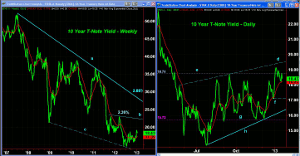Could a near-term rise in yields finally break the bond bull and send money flowing into stocks? MoneyShow's Tom Aspray shares the key levels to determine whether this long-term trend is finally reversing.
As we head into the final two weeks of January, analysts are more hopeful about the stock market in 2012. Many believe that if stocks close higher in January, it is a positive sign for the whole year.
So far, it has been a very good month, as the Spyder Trust (SPY) is up 4.1% and the SPDR Diamonds Trust (DIA) has gained 4.2%, topped by a 5% gain in the iShares Russell 2000 (IWM). The tech-heavy Powershares QQQ Trust (QQQ) continues to lag, up just 3%.
The sharp uptick of interest rates in the first few days of 2013 had some bondholders worried, but since then rates have drifted slightly lower. The positive action in stocks last week may have tempted a few bondholders to consider stocks. but it will take more conclusive evidence of higher rates before they are ready to sell their bonds.
Still, it is important to know what key interest rate levels that an investor should watch in order to identify changes in the trend for either short or long term rates.
Chart Analysis: The weekly chart of the ten-year T-Note yield (TNX) shows the high in yield at over 5% in early July 2007.
- In late 2008, the yield had dropped to a low of 2.1%. Then, it formed even lower lows in the summer of 2012 (line c), as the yield dropped to 1.39%.
- The rally from these lows looks pretty minor on the long-term chart, even though the 20-week EMA (in red) has been overcome.
- The weekly chart shows that the first meaningful resistance (line b) is at 2.25%, with the early 2012 high at 2.36%.
- The long-term downtrend in yield (line a) is now at 2.86%.
The daily chart of the ten-year T-Note yield clearly shows the uptrend (line h) from the July 2012 lows.
- The near-term resistance (line e) at 1.87% was overcome in early 2013.
- The price action in 2012 and early 2013 could be a continuation or flag formation (lines d and h) with the upper boundary currently at 1.948%.
- The yield is currently above its 20-day EMA, with first key support (line f) now at 1.71%.
- The daily uptrend (line h) is now at 1.62%, with even more important support now at 1.57% (line g). A break of this support would project a new low in yield.
NEXT: What 30-Year Rates Can Tell Investors
|pagebreak|
The monthly chart of the 30-year T-Bond goes back to 1995, when the yield peaked at 8.07%. Of course, in May 1984, the yield was at 12.87%.
- The longer-term yield also made new lows in 2012 at 2.46%.
- This was below the late 2008 low of 2.52%.
- While the yield is up 23% from the lows, it is still well below the 20-month EMA at 3.64%.
- The long-term downtrend from the 2000 highs is now at 4.41%, which is now the major level of resistance.
The daily chart of the 30-year T-Bond yield shows the rebound in yields from last year’s lows, as the yield made slightly higher highs in early 2013 at 3.12% (line d).
- This high and the downtrend (line b) need to be overcome to signal that yields are going to move even higher.
- The major resistance (line c) that corresponds to the early 2012 high is now at 3.49%. If this level is overcome, it would be the first sign that a more significant low in yields could be in place.
- Yields are above the rising 20-day EMA, which is now at 2.941%.
- There is minor support now at 2.85% and the short term uptrend (line e).
- 2.715% (line f) is now more important support, which if broken will re-establish the downtrend in rates.
- The continuation pattern that formed from October 2011 through March 2012 looks somewhat similar to the recent trading range.
What it Means: For now, keep your eye on the 2% and 2.36% yield on the ten-year T-Notes as key levels of resistance. If the support at 1.71% is broken, it would be the first sign that yields have resumed their downtrend, and a drop below 1.57% will confirm it.
As for longer-term rates, the minor level of resistance for the 30-year T-Bond yield is 3.12%, followed by a more important level at 3.49%. If this level is surpassed, yields could rise to 3.8%. Conversely, a break below a yield of 2.715% will be a sign of lower rates ahead.
As I discussed in Friday’s Week Ahead column, the current price and yield analysis of the junk bond market indicates that they are now at overvalued levels. Therefore, I would not recommend them at this time.
How to Profit: No new recommendation.
Portfolio Update: In ProShares Ultrashort 20+ Treasury (TBT), investors should be 50% long at $64.48 and 50% long at $63.88, with a stop at $60.63. On a move above $66.10, raise the stop to $62.22.













